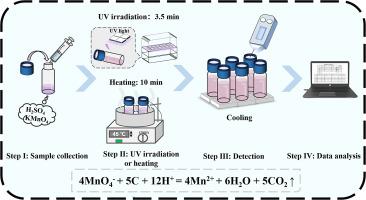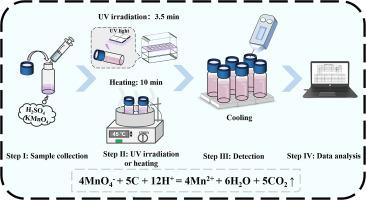Heating and ultraviolet irradiation: Gas pressure meter-based analytical system for on-site and rapid monitoring of permanganate index (CODMn)
IF 11.4
1区 环境科学与生态学
Q1 ENGINEERING, ENVIRONMENTAL
引用次数: 0
Abstract
Permanganate index (CODMn) is one of the important indicators of surface water quality measurement. Herein, a portable analytical system was developed for on-site and rapid analysis of CODMn, organic substances in water were oxidized and transformed into gases, so that CODMn concentration was converted into a change of gas pressure signal, the pressure signal change was further detected by a gas pressure meter. Heating method and ultraviolet (UV) irradiation method were used as assisting technologies for oxidization of organic substances by acidic KMnO4, a linear range of 2–150 mg l-1 and a detectable limit of 2 mg l-1 were obtained. Those methods were further applied to the detection of CODMn in various water samples (lake waters and domestic sewage) and certified reference water samples (BWZ 6974–2016C and BWZ 7617–2016), with recoveries of 89–111 %. Among them, a portable analytical system based on UV irradiation gas pressure meter was further established and used for the analysis of CODMn in field. It is a promising analytical system/device for CODMn monitoring in field, offering advantages of low-cost, easy-operation, portability and rapidness.


加热和紫外线照射:现场快速监测高锰酸盐指数(CODMn)的基于气体压力计的分析系统
高锰酸盐指数(CODMn)是地表水水质测量的重要指标之一。本文开发了一种用于现场快速分析 CODMn 的便携式分析系统,将水中的有机物氧化并转化为气体,从而将 CODMn 浓度转化为气体压力信号的变化,压力信号的变化由气体压力计进一步检测。采用加热法和紫外线(UV)照射法作为酸性 KMnO4 氧化有机物的辅助技术,获得了 2-150 mg L-1 的线性范围和 2 mg L-1 的检测限。将这些方法进一步应用于各种水样(湖水和生活污水)和认证参考水样(BWZ 6974-2016C 和 BWZ 7617-2016)中 CODMn 的检测,回收率为 89-111%。其中,基于紫外照射气体压力计的便携式分析系统被进一步建立并用于现场分析 CODMn。该分析系统/设备具有成本低、操作简便、便携快速等优点,是一种很有前景的 CODMn 现场监测分析系统/设备。
本文章由计算机程序翻译,如有差异,请以英文原文为准。
求助全文
约1分钟内获得全文
求助全文
来源期刊

Water Research
环境科学-工程:环境
CiteScore
20.80
自引率
9.40%
发文量
1307
审稿时长
38 days
期刊介绍:
Water Research, along with its open access companion journal Water Research X, serves as a platform for publishing original research papers covering various aspects of the science and technology related to the anthropogenic water cycle, water quality, and its management worldwide. The audience targeted by the journal comprises biologists, chemical engineers, chemists, civil engineers, environmental engineers, limnologists, and microbiologists. The scope of the journal include:
•Treatment processes for water and wastewaters (municipal, agricultural, industrial, and on-site treatment), including resource recovery and residuals management;
•Urban hydrology including sewer systems, stormwater management, and green infrastructure;
•Drinking water treatment and distribution;
•Potable and non-potable water reuse;
•Sanitation, public health, and risk assessment;
•Anaerobic digestion, solid and hazardous waste management, including source characterization and the effects and control of leachates and gaseous emissions;
•Contaminants (chemical, microbial, anthropogenic particles such as nanoparticles or microplastics) and related water quality sensing, monitoring, fate, and assessment;
•Anthropogenic impacts on inland, tidal, coastal and urban waters, focusing on surface and ground waters, and point and non-point sources of pollution;
•Environmental restoration, linked to surface water, groundwater and groundwater remediation;
•Analysis of the interfaces between sediments and water, and between water and atmosphere, focusing specifically on anthropogenic impacts;
•Mathematical modelling, systems analysis, machine learning, and beneficial use of big data related to the anthropogenic water cycle;
•Socio-economic, policy, and regulations studies.
 求助内容:
求助内容: 应助结果提醒方式:
应助结果提醒方式:


